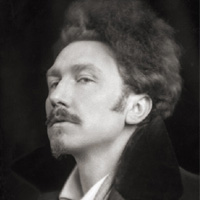In a Station of the Metro by Ezra Pound: Summary and Analysis
In a Station of the Metro published in 1913 by Ezra Pound is the best example of Imagist poetry that contains just 14 words reduced from thirty lines which depict the precision of language. This poem is one of the verb-less poem among the very few.

Ezra Pound (1885-1972)
Pound describes his experience in a metro station in Paris in this poem. The different faces of individual in the metro station is best shown in the poem with an equation of words. This kind of treatment of the words creates a visual effect which is known as the quintessential Imagist text.
This poem is extremely short, but carries a deep meaning with it. On the surface, this poem has two separate images: the crowd and the branch. Actually, Pound is placing one image on top of the other, so that we see them as a single image. Therefore, the faces in the crowd become beautiful, like flower petals on a rainy day. The petals, meanwhile, become faces in a crowd. This new combined image is the real "apparition" - it floats before our eyes like a ghost which lives in no particular time or place.
Written in Japanese famous poetic form haiku, Pound in three lines (including the title) creates a chain of images like the metro station, the apparition, the faces in the crowd and the petals on a wet black bough. The title of the poem creates the visual image of the busy city life with the hustle and bustle of the people and their carelessness to other people. The apparition literally means ghostly figure that suddenly appears in front of you. Here, Pound equates the new strange faces seen in a Paris subway with the apparition. These apparitions are mysterious, and the poet shows the expression of surprise. The faces in the crowd are blurred for the poet and he finds inexpressible beauty in that blur vision. Till now the words and their images, create a visual image of something undesirable and messy situation of metro life. But the sudden image of "petals on a wet, black bough" amazes because of the unexpected beauty in a boring city metro station. The unexpected beauty in an unexpected place is beautifully and tactfully presented in a very precise way. This is the exact power and splendor of the Imagist poetry to depict the relationship among the different images to cater a beautiful meaning. The ‘apparition’ and the ‘petals on a wet, black bough’ are distinctly opposite images that create two distinct images in our minds, but the poet surprisingly delivers a stunning message to see beauty in chaos and in the humdrum of life. The color, shape and size of a person may vary, but each has his/her own beauty that may be an inner or outer beauty.
The human life is described and summarized in just few imagery that goes beyond the limits of standard imagery. ‘Petals on a wet, black bough’ is the phrase which vividly shows the elegance of life and meanwhile show the impermanence of human life. Petals are found in nature in various vibrant colors which represents different human faces and the petals that lie in the wet, black bough symbolizes the transitory ness of life. It was alive and attached to its stem few moments earlier and now it is on the wet surface of bough lying lifeless. It may live a few moments long, but not longer. This metaphor of petals on the surface of bough powerfully yet simply summarizes the human life and its shortness: we all are mortal being.
